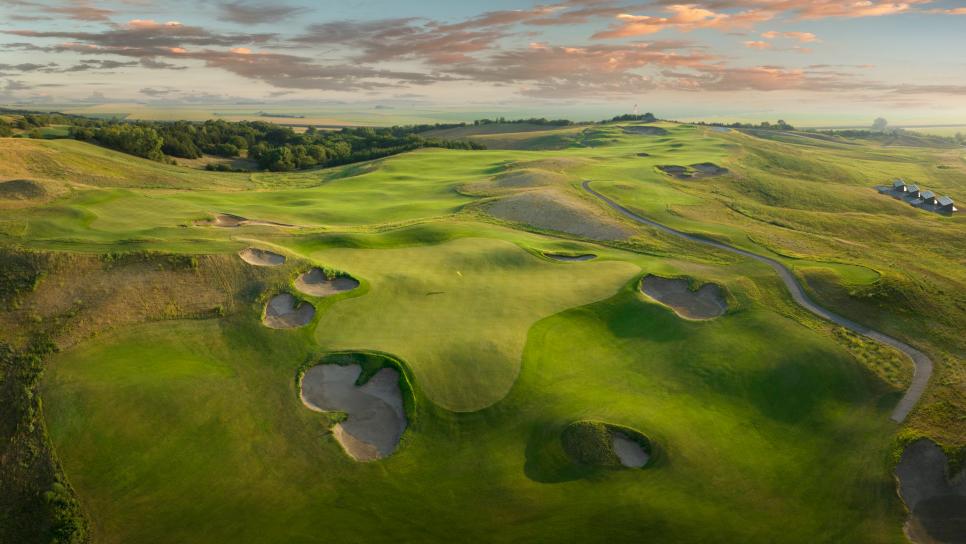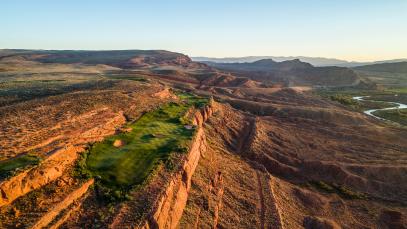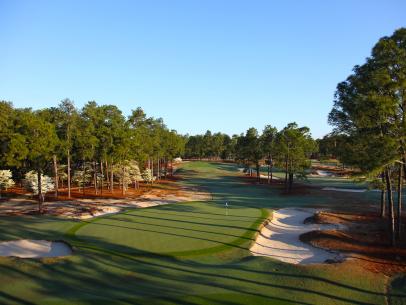Courses
Landmand is golf’s hottest new course, built by Sweetens Cove’s designers, and we got a first look

You don’t show up to a gunfight with a knife. You don’t angle for marlin with your creek fishin’ pole. And you don’t build a country club course in the wilderness of the Loess Hills.
Landmand is no country club course. Located on the Nebraska side of the Missouri River 20 minutes from Sioux City on the region’s heaving, glacially forged land, it is the first new 18-hole design from Rob Collins and Tad King, creators of the nine-hole wonder-course Sweetens Cove outside Chattanooga, where day passes sell out months in advance if not longer. Fans of their work—and they’re counted by the thousands—have waited years to find out what the genre-bending leitmotifs that burble through the Sweetens Cove floodplain might look like on a proper golf site in fuller scale. The wait is over.
Landmand thunders over the tops of ridges and plunges into basins and valleys. Horizons stretch 20 miles or more from the elevated ridges. The holes are expansive to fill up the enormous airspace with Titanic-sized bunkers and greens and fairways flexing out to over 100 yards across, though they present advantageous A lines to the greens, B lines, and even C, D and F lines. It’s not easy to miss them, but just being within fairway confines doesn’t guarantee a good path to the hole.
The property belongs to the Andersen family, who have been farming the surrounding area for generations. The terrain the golf course occupies was too tilted and onerous for productive crops, prompting Will Andersen to contemplate whether it could serve another purpose, in this case golf. It could, but only with a lot of work. He hired King-Collins to come up with the gameplan after several other architects said the land was either too severe or the odds were stacked against this project being successful in such a desolate destination. We’ll see about that: When Landmand began booking tee times for the month of September, they sold out Sweetens Cove-style in just days.

The 17th hole (foreground) is a magnificent downhill par 4 with a putting surface that stretches out to 34,000 square feet. The first hole is in the background (left).
Bill Hornstein
The holes are nothing if not extraordinary, in the essence of the word: They are beyond ordinary. The dimensions and topographical intensity put it in league with modern outsize courses like Mammoth Dunes, Streamsong Black and Old Macdonald. At those courses and here, driving the ball is the carrot on the end of the stick. If fun golf is swinging hard, finding the ball and figuring out the next move, Landmand is entertainment nonpareil.
The short par 4s are particularly worth the trip down the dusty back roads. Most modern courses settle for one potentially drivable short hole, but Landmand puts four on the card—the best being the second, where drives that clear the skyline bunker on the left can tumble all the way down to half-pipe green, and those that don’t have to puzzle around a large grassy knob in front of the putting surface—and the 315-yard 17th playing downhill to a taffy-twisted 34,000-square-foot green (yes, 34,000 square feet) riffing on the old but extinct Sitwell Park green in England that Alister MacKenzie admired for its audaciousness (image search it).
Other standouts include the relatively subtle par-4 ninth shooting down and out to a corner of the cornfields with a wavy, angled green, and the massive Redan 14th. The impulse to construct a version of the Redan at every new course has been tiresome for a long time, except when they’re as big and results-oriented as Landmand’s. Balls that land toward the extreme right edge of the green will slope-kick down to the left, and players will want to stand on the tee and hit shot after shot until they catch one just right for the thrill of seeing the ball jettison 30 yards across the green toward the lower pins (they can only be cut on the left third).
About those greens. Golfers who profess their love of extreme shape and contour will have that conviction put to the test. The average size of the greens is more than 14,000 square feet and there are several, like that of the par-3 fifth and par-5 15th, which are half an acre in size (the green on a typical course is about 6,000 square feet). The contours are bulbous, and being on the wrong side of a two-foot-high buckle or swale is a quick way to surrender strokes or lose a hole. Three- and four-putts, even five-putts if you insist on holing out, are common. But overall they work because most are benched into landforms or cut onto plateaus with run-ups, rather than plotted like fresh burial mounds ala Sweetens Cove. Those that do possess steep falloffs on one or two sides leave less than punishing recoveries since there’s ample interior area to play up to.
The exceptions are the greens at Nos. 4 and 7, both short par 4s, that might have been pushed too hard. The drives give players the chance to get close, but the fourth green is elevated and curled into a boomerang shape with the front left lobe cresting down on the side. Hole locations cut close to it are vengeful, and any lofted, semi-blind approach coming up a little short to any section of the green (and they all need to be lofted to clear a frontal bunker) will be repulsed into a deep Valley of Sin that’s going to get more than its share of action with the usual high winds. The seventh green is similarly borderline, like a jellybean smashed into a hillside—chips and pitches that don’t hold could commence a frustrating game of back and forth across the domed surface.
A dry barranca zigzags down the valley center of the par-4 third (below). It’s a cool, visually arresting feature with chunked grassy banks that can cause half-stroke penalties if balls nestle too close, but as a standalone set piece it’s more a curiosity than a cohesive golf feature. It would have been more effective to carry out the theme by carving other barrancas through the low areas of holes like the par-5 sixth and the down-up par-4 13th, or used to divide the landing area at the cross-ravine 16th in lieu of the off-centerline bunker.

Derek Duncan
Most golfers won’t quibble. Landmand is today’s bass drum of public golf, hitting the market with an echoing boom. It’s the right course for the right moment, with a sky full of space, options to play your way and greens that demand right-brain virtuosity. For those who seek the rush of exploration and discovery, there’s a new pin in the map.




